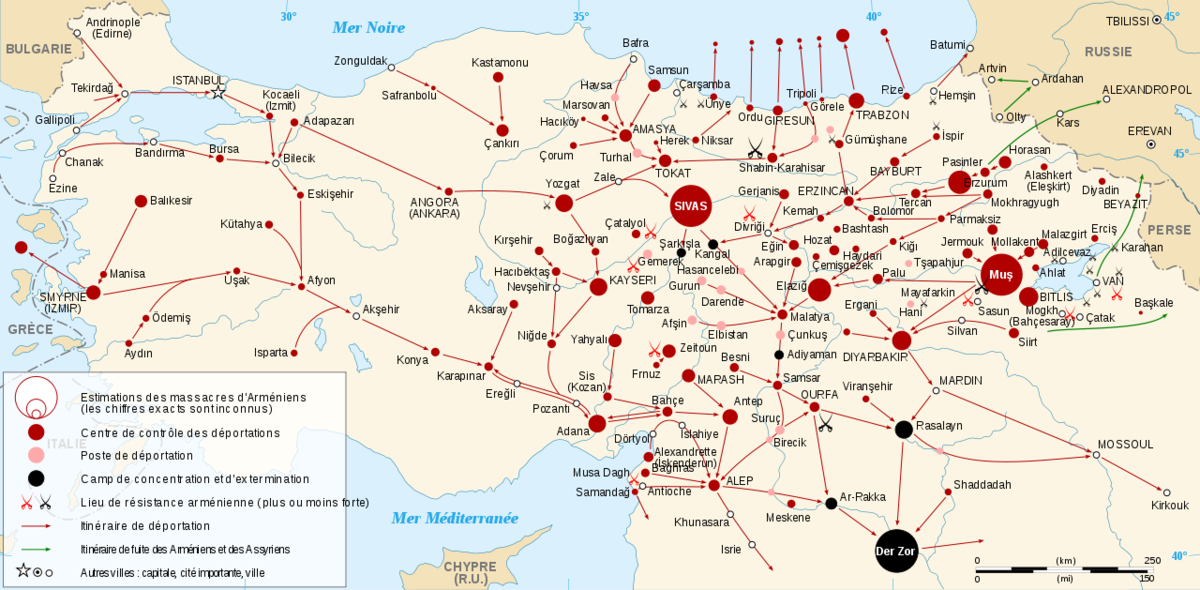The Armenians were one of the peoples in the Ottoman Empire. The majority of them lived close to the Caucasus and in Cilicia. Some lived in Istanbul, while others made homes for themselves in Lebanon or Jerusalem. The population of this Christian group numbered 2 million by the end of the 19th century, while the total population of the Ottoman Empire was 36 million.
The Ottoman Empire was in rapid decline before World War I. Its leaders were no longer able to hold the vast territory together. The sultan provoked religious hatred among different cultures to ensure the stability of his power. The population was increasingly demanding the modernization of the Empire in order to make it more functional.
Between 1894 and 1896, Armenians too were asking for more reforms as well as the modernization of the Empire’s institutions. The sultan’s response was to order the massacre of these protesters.
Between 200 000 and 250 000 Armenians were killed, while a million others were stripped of their possessions. Thousands were forcibly converted to Islam. Churches were burned or converted into mosques, and several hundred villages were gutted and looted.
Western countries immediately protested, but no sanctions were imposed.
The sultan lost power in 1909 during the Young Turk Revolution. The new sultan wanted to bring about the changes and modernization rejected by former leaders. The new sultan provided the Empire with a new constitution and a currency similar to that of France. The new leaders then hinted that they would give more freedom to the Empire’s minorities by establishing a new, secular society.
However, the Young Turks were relying on increasingly stronger nationalism. The evolving Ottoman Empire shifted its focus to Asia, distancing itself from Europe.
A new ideology, Turanism, was born, which focused on the union of Turkish-speaking peoples. This was how the desire to create a racially homogeneous Turkish nation came about. This desire resulted in new attacks on the Armenian people, causing 20 000 to 30 000 deaths in Asia Minor.
The Young Turks applied discriminatory nationalistic policies throughout the Empire: boycotting trade with Greeks, Jewish or Armenian people and rewriting history by minimizing the place and influence of the Ottoman era.
On February 8, 1914, Russia sent an international commission, intended to ensure that relations among the different populations of the Ottoman Empire were good. The Turks felt humiliated by this initiative. The Ottoman Empire declared war on November 1, 1914 and allied itself with the German and Austro-Hungarian empires. The Turkish army was defeated in Russia on December 29, 1914, while it was attempting to rally Russian Armenians to its cause.
Following this defeat, the Ottoman Empire was invaded, causing 100 000 deaths and leading to the retreat of the Empire’s army. This departure intensified the attacks against Armenians, who were targeted in every region crossed by the retreating army. These violent attacks motivated Turkish Armenians to ally themselves with Russia. A new Armenian government was proclaimed on April 7, 1915.
After this declaration, the Young Turks were set on the elimination of Armenians in Asia Minor. They considered Asia Minor to be the exclusive national home of the Turks. Talaat Pacha, the Minister of the Interior, gave the order to execute Armenians in Istanbul. The genocide began on April 24, 1915, when 600 notable Armenians were assassinated in Istanbul.
After this massacre, Talaat Pacha ordered the assassination of Armenians in the army, even those who had thoroughly proven their loyalty to the Turkish army. The elimination order then targeted all Armenians in the 7 Eastern provinces of the Empire. Leaders also gave the order to use any means, criminal or not, to disregard the sex or age of the Armenians, and to have no scruples in executing these orders. Any official who did not adhere to this idea was deposed.
The first steps of the genocide were to deport all men under 20 and over 45 years of age. They were subjected to hard labour and many of them were killed or died from overwork. On May 27, 1915, the Temporary Law of Deportation called for the deportation of survivors and the dispossession of the victims’ property. This law was applied in the name of national security.
A genocide is the intentional and organized extermination of an ethnic, religious or social group. It is a crime against humanity under international law.

Carte de la déportation des Arméniens
The deportation also applied to women and children. The youngest and prettiest women were sold as slaves and even forcibly converted to Islam, before being married to Turks.
Deportees were often sent to desert regions where they succumbed to the climate conditions. A total of two-thirds of the Armenian population died during the summer of 1915.
Western leaders heard about the fate of the Armenians as soon as the genocide began. However, the sultan responded to any accusations of genocide by stating that population movements were only carried out in the name of military operations. The German government, allied with the Ottoman Empire, censored information about the genocide. After the war, the leaders of the genocide took refuge in Germany, including Talaat Pacha, who was assassinated in Berlin.
On August 10, 1920, the Treaty of Sèvres was signed. This was the agreement between Western countries and the Ottoman Empire for trials of the perpetrators. These trials never took place because a Turkish general proclaimed general amnesty in 1923. The Armenian genocide was almost forgotten by Western countries until 1980, when new research was carried out and new witness statements were given. Nonetheless, Turkey has never acknowledged the role its government played in the genocide. The country acknowledges the deaths and deportations, but does not acknowledge that this was a genocide.